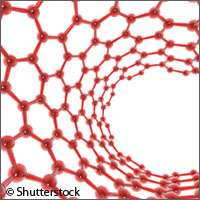Seeing red? Making carbon nanotubes clearer to the naked eye

If you were to look at a carbon nanotube with the naked eye you wouldn't see much more than black powder, but now a team of EU-funded scientists has developed a novel way of making these multi-purpose nanotechnology building blocks more visible.
Carbon nanotubes are structures that resemble lots of honeycomb-shaped hexagons all rolled-up into a seamless cylindrical tube. It is difficult to make them emit light as they are excellent electrical conductors and capture the energy from other luminescent chemical species placed nearby.
Yet now the pan-European team has worked out ways to make use of the carbon nanotubes' relatively high surface area, which allows many other molecules, including those capable of emitting light, to attach themselves to it. These molecules take the form of chemicals that are able to display red light.
As part of an EU project, researchers from Belgium, France, Germany, Hungary, Italy and Poland have been preparing and characterising luminescent materials in which suitably designed organic and inorganic luminophores are encapsulated within nano-containers (i.e. carbon nanotubes and coordination cages) in which they can preserve and even improve their emission output.
The project's ultimate goal is to create a library of luminescent modules emitting throughout the VIS-NIR region for producing superior functional hybrid materials. The emission colour tunability is defined by the emitting guest, while the versatility in the final application is controlled via tailored chemical functionalisation of the host.
"We take part in the project as a research group specializing in studies on lanthanide compounds. We decided to combine their high luminescent properties with excellent mechanical and electrical characteristics of nanotubes," says Professor Marek Pietraszkiewicz from Warsaw's Institute of Physical Chemistry of the Polish Academy of Sciences (IPC PAS), one of the FINELUMEN consortium partners.
However, the team discovered that it was not just a simple case of sticking on these light-emitting molecules, as researcher Valentina Utochnikova from IPC PAS explains:
"Attachment of light-emitting complexes directly to the nanotube is, however, not favourable, because the latter, as a black absorber, would highly quench the luminescence."
To combat this unwanted light absorption, the team first subjected the carbon nanotubes to a thermal reaction at 140 to 160 degrees Celsius in a solution of ionic liquid modified with a terminal azido function. The reaction yields nanotubes coated with molecules acting as anchors-links. On one side, the anchors are attached to the surface of the nanotube, and on the other they can attach molecules capable of displaying visible light. The free terminal of each link bears a positive charge.
So prepared nanotubes are subsequently transferred into another solution containing a negatively charged lanthanide complex -- tetrakis-(4,4,4-trifluoro-1-(2-naphtyl-1,3-butanedionato)europium.
"Lanthanide compounds contain elements from the VI group of the periodic table and are very attractive for photonics, as they are characterised by a high luminescence quantum yield and a high colour purity of the emitted light," comments Valentina Utochnikova.
After dissolving in solution, negatively charged europium complexes are spontaneously caught by positively charged free terminals of anchors attached to nanotubes due to electrostatic interaction. Subsequently, each nanotube is durably coated with molecules capable of emitting visible light. Once the reaction is completed the modified nanotubes are then washed and dried.
The final result is a sooty powder that when exposed to UV radiation emits red light thanks to the lanthanide complexes anchored to the carbon nanotubes.
By making these materials as versatile as possible there is huge potential for their increased use in bioimaging, optoelectronic devices and sensors.
Provided by CORDIS















